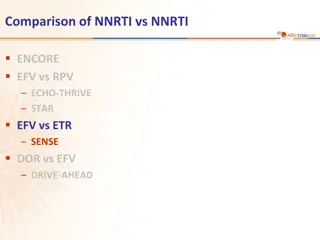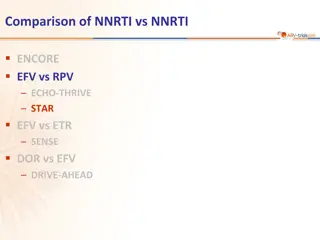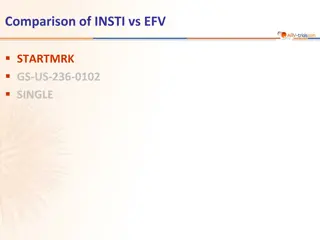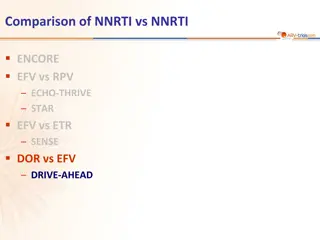Comparison of NNRTI vs. NNRTI in SENSE Study
The comparison between Etravirine (ETR) and Efavirenz (EFV) in the SENSE Study showed differences in neuropsychiatric adverse events, treatment response, and patient characteristics. ETR with 2 NRTIs resulted in fewer drug-related adverse events than EFV with 2 NRTIs. ETR also showed better response
0 views • 7 slides
Comparison of NNRTI vs. NNRTI and RPV/FTC/TDF vs. EFV/FTC/TDF in STAR Study
STAR Study compared the efficacy and safety of RPV/FTC/TDF and EFV/FTC/TDF in treatment-naive HIV patients. The study included 394 participants in each group, assessing HIV RNA suppression rates, CD4 count improvements, treatment responses, and resistance analyses up to 48 weeks. Results showed RPV/
0 views • 15 slides
Comparison of INSTI vs. EFV in STARTMRK GS-US-236-0102
In the STARTMRK study, Raltegravir (RAL) was compared to Efavirenz (EFV) in combination with TDF/FTC for the treatment of HIV. The study aimed to demonstrate non-inferiority of RAL compared to EFV in achieving HIV RNA levels below 50 c/mL. Baseline characteristics and patient disposition were assess
0 views • 12 slides
Comparison of NNRTI vs NNRTI and DRIVE-AHEAD Study: DOR/3TC/TDF vs EFV/FTC/TDF
The comparison study explores NNRTI regimens alongside the DRIVE-AHEAD trial, focusing on DOR/3TC/TDF vs EFV-FTC/TDF. DRIVE-AHEAD assesses the efficacy and safety of DOR in ARV-naïve HIV patients, aiming for non-inferiority based on virologic response, with DOR exhibiting potential neuropsychiatric
0 views • 11 slides
Managing Viral Load in Patients on ART: Case Study of Nondumiso
Nondumiso, a patient on TDF/FTC/EFV for a year, faces challenges with adherence despite good health and stability. With a VL of 1500, a thorough assessment is needed to address possible causes such as adherence, infections, dosing, interactions, and resistance. Follow-up testing, interventions, and
0 views • 23 slides




